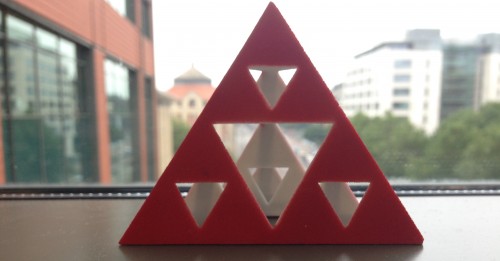
Pyramid power: this lovely object has nothing to do with postdocs. It is a simpler version of a much larger Sierpinski tree that can be found on London’s South Bank.
By Hamish Johnston
Just this week six people were convicted in Bristol of crimes related to running a pyramid scheme. This involves taking money from lots of new investors and giving it to a smaller number of investors who signed up earlier – until the pyramid collapses. Is the current model for training scientists a pyramid scheme of sorts? That is the claim in a piece on the US’s National Public Radio (NPR) website written by Richard Harris.
The article ponders the role of the postdoc, someone who has finished their PhD and in principle is working for a year or two in a temporary research job before taking a tenure-track position at a university. The article points out that there are about 40,000 postdocs working in the US, but only about 15% will get tenure-track jobs. “The entire system is built around the false idea that all these scientists-in-training are headed to university professorships,” Harris concludes.
Biologist Keith Micoli explains why he thinks the system thrives: “We’ve grown so dependent on this relatively cheap, seemingly inexhaustible supply of young scientists who do great work. From the standpoint of dollars and cents, they’re a great investment.”
So why do scientists wager years of training on such poor odds? They tell their story in “Too few university jobs for America’s young scientists”.
From pyramids to sacred spherical cows, David Kaiser of the Massachusetts Institute of Technology has written a lovely article that charts the role of symmetry in the development of theoretical particle physics. The piece is called “The sacred, spherical cows of physics” and begins with the quantum revolution of the 1920s. It ends late last year, with a new approach to symmetry based on the “amplituhedron” that has been proposed by Nima Arkani-Hamed and Jaroslav Trnka at the Institute for Advanced Study in Princeton. Kaiser, by the way, wrote How the Hippies Saved Physics, which was Physics World‘s 2012 Book of the Year.
Maybe one reason why young people are so keen on pursuing a career in scientific academia is the phenomenal success of television’s The Big Bang Theory, which, in case you don’t know, features physicists and other scientists as its main characters. The UCLA physicist David Saltzberg is the show’s scientific advisor and over on Slashdot this week he answered reader’s questions. When asked whether the programme advances the cause of science, he observed that Gary White, the former director of the US Society of Physics Students, told him that physics students are “standing a little taller”.
Someone asked Saltzberg whether the show’s writers ever went ahead with a scientific inaccuracy that he warned against? No, he said, but he pointed out that how the characters’ jobs are organized within their university, and who supervises them, isn’t realistic. I suppose the postdoc system would be too fantastical for viewers to believe!
And if you want Physics World‘s own insights into The Big Bang Theory, don’t forget our behind-the-scenes look at the show and our recent podcast with another Big Bang hanger-on, Sean Carroll.
Finally, one of my favourite episodes of The Big Bang Theory focuses on the thwarted attempts of theoretical physicist Sheldon Cooper to visit the Large Hadron Collider (LHC) at CERN. Cooper is heartbroken on missing out on a trip to Geneva, and that episode reminds me of how privileged I have been to visit the lab several times – and even tour the tunnels and caverns of the LHC and its experiments.
It is now 60 years since CERN came into being, and throughout September the lab is celebrating its diamond jubilee. For more information see “CERN celebrates 60 years of science” and stay tuned to Physics World for more coverage of the festivities.
Thank you, Nice Info